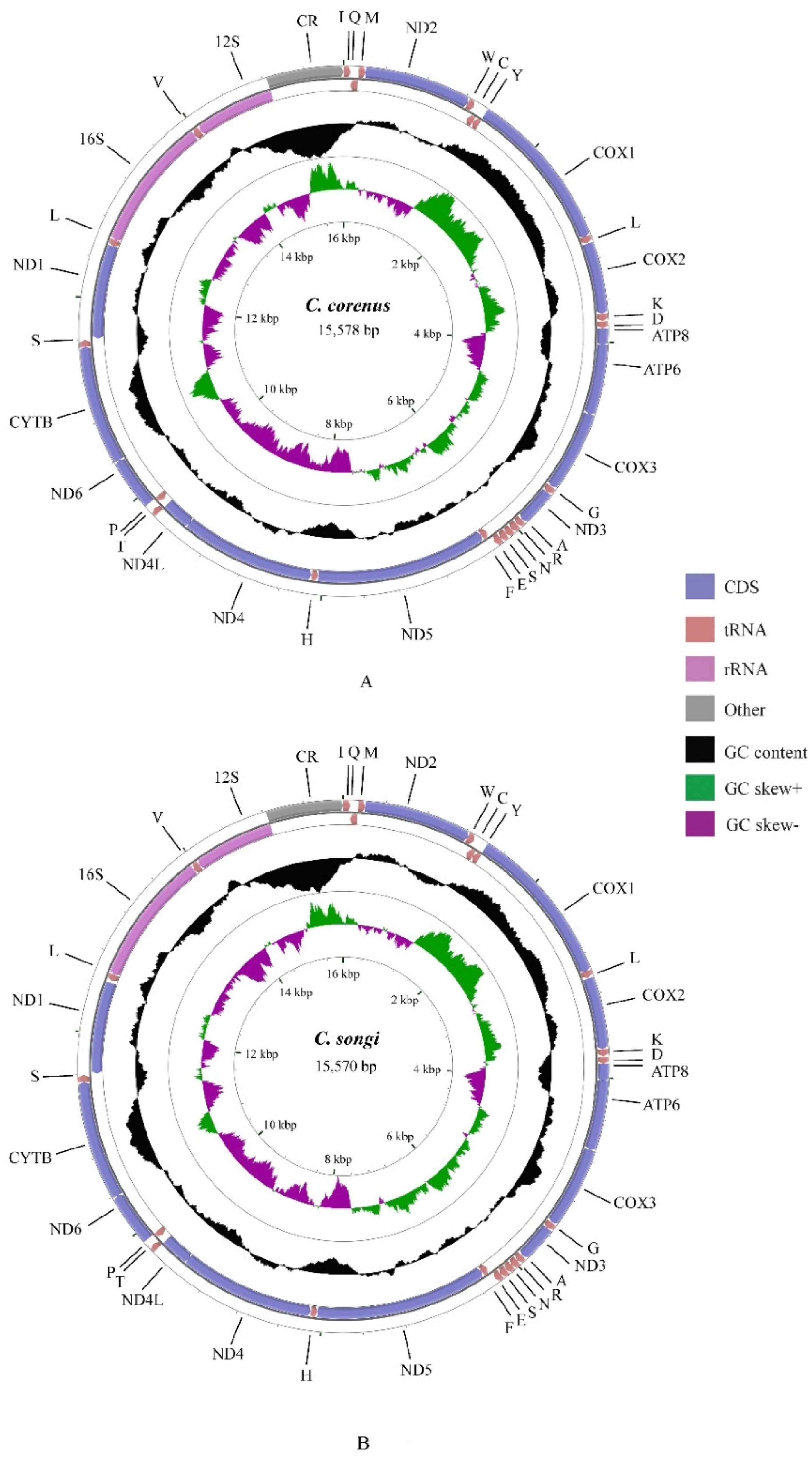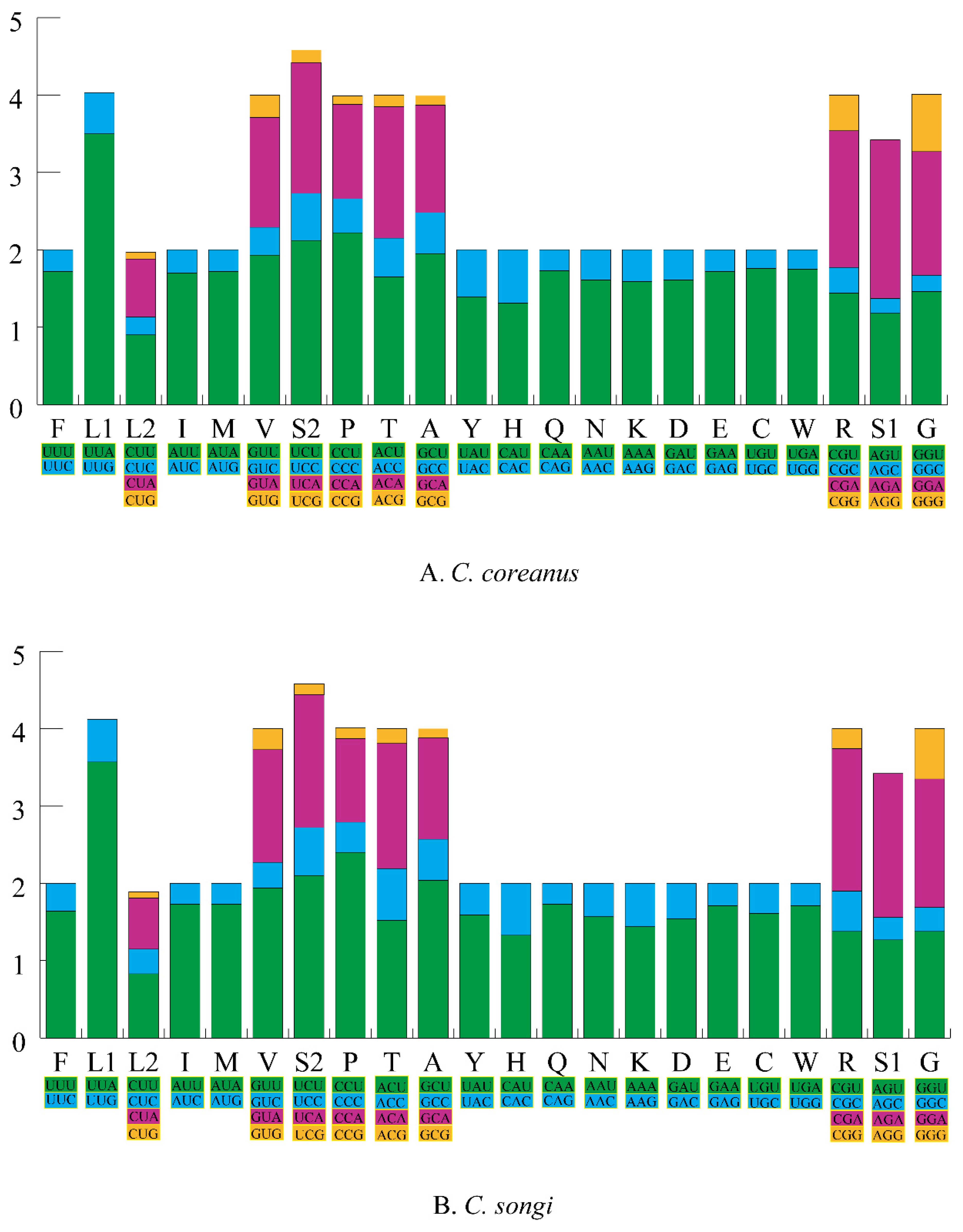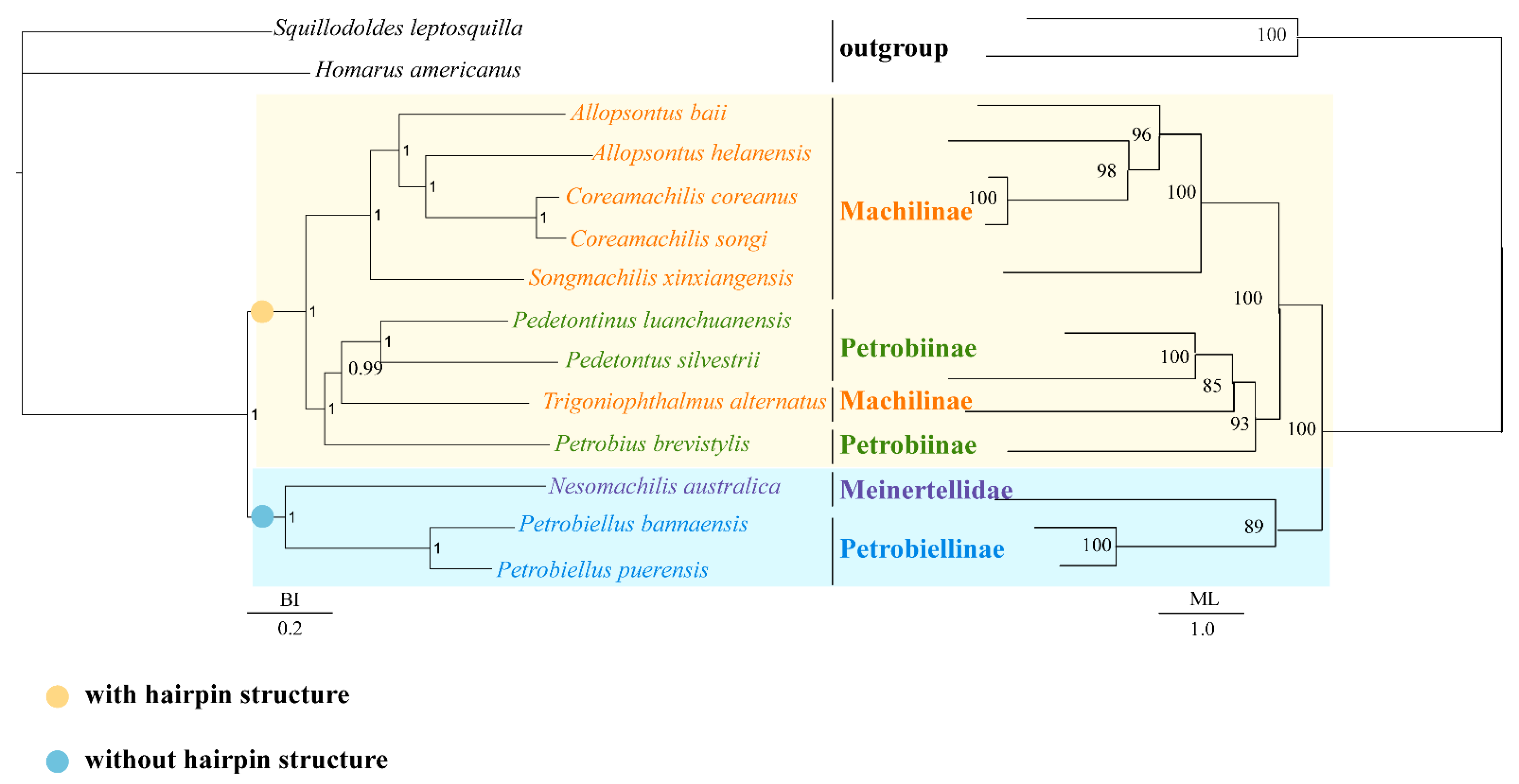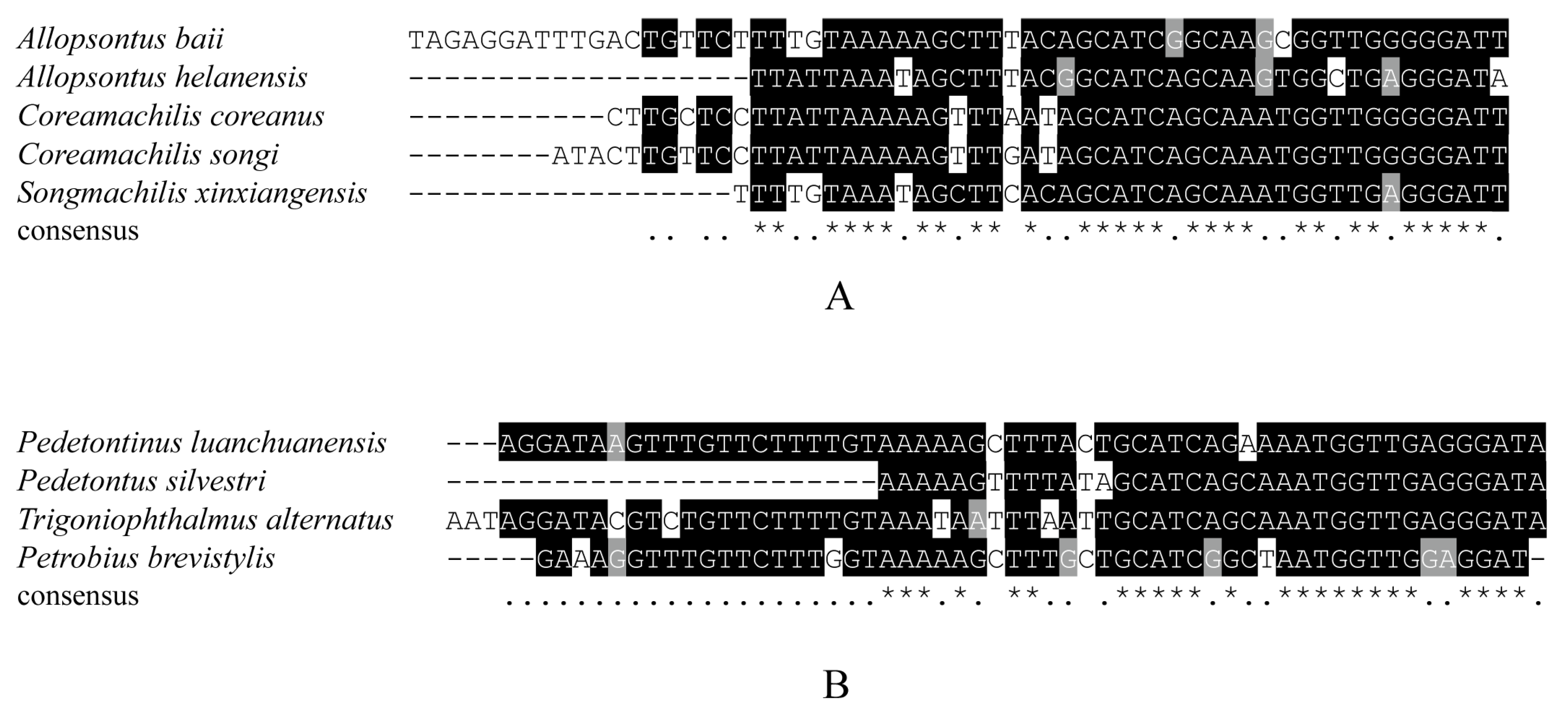Comparative Mitogenomes of Two Coreamachilis Species (Microcoryphia: Machilidae) along with Phylogenetic Analyses of Microcoryphia
Abstract
Simple Summary
Abstract
1. Introduction
2. Material and Methods
2.1. Specimen Collection and DNA Extraction
2.2. Polymerase Chain Reaction (PCR) Amplification and Sequencing
2.3. Sequence Analyses and Annotation
2.4. Phylogenetic Analyses of Microcoryphia
2.5. Selection Pressure Analyses of Coreamachilis
3. Results and Discussion
3.1. Specimen Collection and Mitogenome Structure
3.2. Protein-Codon Genes and Codon Usages
3.3. Ribosomal RNAs, Transfer RNAs and Hairpin Structures
3.4. A + T Rich Region
3.5. Phylogenetic Analyses and Selection Pressure Analyses
4. Conclusions
Supplementary Materials
Author Contributions
Funding
Institutional Review Board Statement
Data Availability Statement
Acknowledgments
Conflicts of Interest
References
- Sturm, H.; Machida, R. Handbook of Zoology; Walter de Gruyter: Berlin, Germany, 2001; Volume 4. [Google Scholar]
- Mendes, L.F. Biodiversity of the Thysanurans (Microcoryphia and Zygentoma). In Insect Biodiversity: Science and Society; John Wiley & Sons: Hoboken, NJ, USA, 2018. [Google Scholar]
- Mendes, L.F. New contribution towards the knowledge of the Northern Korean thysanurans (Microcoryphia and Zygentoma: Insecta). Garcia Orta 1991, 18, 67–78. [Google Scholar]
- Zhang, J.Y.; Zhou, K.Y. Descriptions of one new genus and six new species of Machilidae (Insecta: Archaeognatha) from China: Morphological and molecular data. J. Nat. Hist 2011, 45, 1131–1164. [Google Scholar] [CrossRef]
- Mendes, L.F. An annotated list of generic and specific names of Machilidae (Microcoryphia, Insecta) with identification keys for the genera and geographical notes. Estud. Ens. Doc. (Port.) 1990, 155, 1–127. [Google Scholar]
- Gassner, M.; Dejaco, T.; Schönswetter, P.; Marec, F.; Arthofer, W.; Schlick-Steiner, B.C.; Steiner, F.M. Extensive variation in chromosome number and genome size in sexual and parthenogenetic species of the jumping bristletail genus Machilis (Archaeognatha). Ecol. Evolut. 2014, 4, 4093–4105. [Google Scholar] [CrossRef] [PubMed]
- Kearney, M.; Blacket, M.J.; Strasburg, J.L.; Moritz, C. FAST-TRACK: Waves of parthenogenesis in the desert: Evidence for the parallel loss of sex in a grasshopper and a gecko from Australia. Mol. Ecol. 2006, 15, 1743–1748. [Google Scholar] [CrossRef] [PubMed]
- Vorburger, C. Geographic parthenogenesis: Recurrent patterns down under. Curr. Biol. 2006, 16, R641–R643. [Google Scholar] [CrossRef]
- Rispe, C.; Pierre, J.S. Coexistence between cyclical parthenogens, obligate parthenogens, and intermediates in a fluctuating environment. J. Theor. Biol. 1998, 195, 97–110. [Google Scholar] [CrossRef]
- Stuart-Fox, D.M.; Ord, T.J. Sexual selection, natural selection and the evolution of dimorphic coloration and ornamentation in agamid lizards. Proc. Biol. Sci. 2004, 271, 2249–2255. [Google Scholar] [CrossRef] [PubMed]
- Krüger, O.; Davies, N.B.; Sorenson, M.D. The evolution of sexual dimorphism in parasitic cuckoos: Sexual selection or coevolution? Proc. Biol. Sci. 2018, 274, 1553–1560. [Google Scholar] [CrossRef] [PubMed]
- Boore, J.L. Animal mitochondrial genomes. Nucleic Acids Res. 1999, 27, 1767–1780. [Google Scholar] [CrossRef] [PubMed]
- Boore, J.L. The use of genome-level characters for phylogenetic reconstruction. Trends Ecol. Evolut. 2006, 21, 439–446. [Google Scholar] [CrossRef]
- Cameron, S.L. Insect Mitochondrial Genomics: Implications for Evolution and Phylogeny. Annu. Rev. Entomol. 2014, 59, 95–117. [Google Scholar] [CrossRef] [PubMed]
- Cheng, X.F.; Zhang, L.P.; Yu, D.N.; Storey, K.B.; Zhang, J.Y. The complete mitochondrial genomes of four cockroaches (Insecta: Blattodea) and phylogenetic analyses within cockroaches. Gene 2016, 586, 115–122. [Google Scholar] [CrossRef]
- Gao, X.Y.; Cai, Y.Y.; Yu, D.N.; Storey, K.B.; Zhang, J.Y. Characteristics of the complete mitochondrial genome of Suhpalacsa longialata (Neuroptera, Ascalaphidae) and its phylogenetic implications. PeerJ 2018, 6, e5914. [Google Scholar] [CrossRef]
- Zhang, L.P.; Yu, D.N.; Storey, K.B.; Cheng, H.Y.; Zhang, J.Y. Higher tRNA gene duplication in mitogenomes of praying mantises (Dictyoptera, Mantodea) and the phylogeny within Mantodea. Int. J. Biol. Macromol. 2018, 111, 787–795. [Google Scholar] [CrossRef] [PubMed]
- Xu, X.D.; Jia, Y.Y.; Cao, S.S.; Zhang, Z.Y.; Storey, K.B.; Yu, D.N.; Zhang, J.Y. Six complete mitochondrial genomes of mayflies from three genera of Ephemerellidae (Insecta: Ephemeroptera) with inversion and translocation of trnI rearrangement and their phylogenetic relationships. PeerJ 2020, 8, e9740. [Google Scholar] [CrossRef] [PubMed]
- Ye, F.; Lan, X.E.; Zhu, W.B.; You, P. Mitochondrial genomes of praying mantises (Dictyoptera, Mantodea): Rearrangement, duplication, and reassignment of tRNA genes. Sci. Rep. 2016, 6, 25634. [Google Scholar] [CrossRef] [PubMed]
- Clary, D.O.; Wolstenholme, D.R. The mitochondrial DNA molecule of Drosophila yakuba: Nucleotide sequence, gene organization, and genetic code. J. Mol. Evolut. 1985, 22, 252–271. [Google Scholar] [CrossRef] [PubMed]
- Clary, D.O.; Wolstenholme, D.R. The ribosomal RNA genes of Drosophila mitochondrial DNA. Nucleic Acids Res. 1985, 13, 4029–4045. [Google Scholar] [CrossRef]
- Fenn, J.D.; Cameron, S.L.; Whiting, M.F. The complete mitochondrial genome sequence of the Mormon cricket (Anabrus simplex: Tettigoniidae: Orthoptera) and an analysis of control region variability. Insect Mol. Biol. 2007, 16, 239–252. [Google Scholar] [CrossRef]
- Hatzoglou, E.; Rodakis, G.C.; Lecanidou, R. Complete sequence and gene organization of the mitochondrial genome of the land snail Albinaria coerulea. Genetics 1995, 140, 1353–1366. [Google Scholar] [CrossRef]
- Hong, M.Y.; Lee, E.M.; Jo, Y.H.; Park, H.C.; Kim, S.R.; Hwang, J.S.; Jin, B.R.; Kang, P.D.; Kim, K.G.; Han, Y.S.; et al. Complete nucleotide sequence and organization of the mitogenome of the silk moth Caligula boisduvalii (Lepidoptera: Saturniidae) and comparison with other lepidopteran insects. Gene 2008, 413, 49–57. [Google Scholar] [CrossRef] [PubMed]
- Kim, I.; Lee, E.M.; Seol, K.Y.; Yun, E.Y.; Lee, Y.B.; Hwang, J.S.; Jin, B.R. The mitochondrial genome of the Korean hairstreak, Coreana raphaelis (Lepidoptera: Lycaenidae). Insect Mol. Biol. 2006, 15, 217–225. [Google Scholar] [CrossRef] [PubMed]
- Yu, X.L.; Tan, W.; Zhang, H.Y.; Jiang, W.L.; Gao, H.; Wang, W.X.; Liu, Y.X.; Wang, Y.; Tian, X.X. Characterization of the complete mitochondrial genome of Harpalus sinicus and its implications for phylogenetic analyses. Genes (Basel) 2019, 10, 724. [Google Scholar] [CrossRef]
- Ballard, J.W.O.; Kreitman, M. Is mitochondrial DNA a strictly neutral marker? Trends Ecol. Evolut. 1995, 10, 485–488. [Google Scholar] [CrossRef]
- Ruiz-Pesini, E.; Mishmar, D.; Brandon, M.; Procaccio, V.; Wallace, D.C. Effects of purifying and adaptive selection on regional variation in human mtDNA. Science 2004, 303, 223–226. [Google Scholar] [CrossRef] [PubMed]
- Moyer, G.R.; Winemeller, K.O.; McPhee, M.V.; Turner, T.F. Historical demography, selection, and coalescence of mitochondrial and nuclear genes in Prochilodus species of northern South America. Evolution 2005, 59, 599–610. [Google Scholar] [CrossRef] [PubMed]
- Bazin, E.; Glémin, S.; Galtier, N. Population size does not influence mitochondrial genetic diversity in animals. Science 2006, 312, 570–572. [Google Scholar] [CrossRef]
- Yang, Y.X.; Xu, S.X.; Xu, J.X.; Guo, Y.; Yang, G. Adaptive evolution of mitochondrial energy metabolism genes associated with increased energy demand in flying insects. PLoS ONE 2014, 9, e99120. [Google Scholar] [CrossRef] [PubMed]
- Li, X.D.; Jiang, G.F.; Yan, L.Y.; Li, R.; Mu, Y.; Deng, W.A. Positive selection drove the adaptation of mitochondrial genes to the demands of flight and high-altitude environments in grasshoppers. Front. Genet. 2018, 9, 605. [Google Scholar] [CrossRef]
- Cai, Y.T.; Li, Q.; Zhang, J.Y.; Storey, K.B.; Yu, D.N. Characterization of the mitochondrial genomes of two toads, Anaxyrus americanus (Anura: Bufonidae) and Bufotes pewzowi (Anura: Bufonidae), with phylogenetic and selection pressure analyses. PeerJ 2020, 8, e8901. [Google Scholar] [CrossRef]
- Mishmar, D.; Ruiz Pesini, E.; Golik, P.; Macaulay, V.; Clark, A.G.; Hosseini, S.; Brandon, M.; Easley, K.; Chen, E.; Brown, M.D.; et al. Natural selection shaped regional mtDNA variation in humans. Proc. Natl. Acad. Sci. USA 2003, 100, 171–176. [Google Scholar] [CrossRef]
- da Fonseca, R.R.; Johnson, W.E.; O’Brien, S.J.; Ramos, M.J.; Antunes, A. The adaptive evolution of the mammalian mitochondrial genome. BMC Genom. 2008, 9, 119. [Google Scholar] [CrossRef]
- Galtier, N.; Blier, P.U.; Nabholz, B. Inverse relationship between longevity and evolutionary rate of mitochondrial proteins in mammals and birds. Mitochondrion 2009, 9, 51–57. [Google Scholar] [CrossRef] [PubMed]
- Marshall, H.D.; Coulson, M.W.; Carr, S.M. Near neutrality, rate heterogeneity, and linkage govern mitochondrial genome evolution in Atlantic cod (Gadus morhua) and other gadine fish. Mol. Biol. Evolut. 2008, 26, 579–589. [Google Scholar] [CrossRef] [PubMed][Green Version]
- Oliveira, D.C.; Raychoudhury, R.; Lavrov, D.V.; Werren, J.H. Rapidly evolving mitochondrial genome and directional selection in mitochondrial genes in the parasitic wasp Nasonia (Hymenoptera: Pteromalidae). Mol. Biol. Evolut. 2008, 25, 2167–2180. [Google Scholar] [CrossRef] [PubMed]
- Ma, C.; Yang, P.; Jiang, F.; Chapuis, M.P.; Shali, Y.; Sword, G.A.; Kang, L. Mitochondrial genomes reveal the global phylogeography and dispersal routes of the migratory locust. Mol. Ecol. 2012, 21, 4344–4358. [Google Scholar] [CrossRef] [PubMed]
- Xu, X.D.; Guan, J.Y.; Zhang, Z.Y.; Cao, Y.R.; Cai, Y.Y.; Storey, K.B.; Yu, D.N.; Zhang, J.Y. Insight into the phylogenetic relationships among three subfamilies within Heptageniidae (Insecta: Ephemeroptera) along with low-temperature selection pressure analyses using mitogenomes. Insects 2021, 12, 656. [Google Scholar] [CrossRef]
- Krzywinski, J.; Li, C.; Morris, M.; Conn, J.E.; Lima, J.B.; Povoa, M.M.; Wilkerson, R.C. Analysis of the evolutionary forces shaping mitochondrial genomes of a Neotropical malaria vector complex. Mol. Phylogenet. Evolut. 2011, 58, 469–477. [Google Scholar] [CrossRef][Green Version]
- Yuan, M.L.; Zhang, Q.L.; Zhang, L.; Jia, C.L.; Li, X.P.; Yang, X.Z.; Feng, R.Q. Mitochondrial phylogeny, divergence history and high-altitude adaptation of grassland caterpillars (Lepidoptera: Lymantriinae: Gynaephora) inhabiting the Tibetan Plateau. Mol. Phylogenet. Evolut. 2018, 122, 116–124. [Google Scholar] [CrossRef]
- Simon, C.; Buckley, T.R.; Frati, F.; Stewart, J.B.; Beckenbach, A.T. Incorporating molecular evolution into phylogenetic analysis, and a new compilation of conserved polymerase chain reaction primers for animal mitochondrial DNA. Ann. Rev. Ecol. Evolut. Syst. 2006, 37, 545–579. [Google Scholar] [CrossRef]
- Ma, Y.; He, K.; Yu, P.P.; Yu, D.N.; Cheng, X.F.; Zhang, J.Y. The complete mitochondrial genomes of three bristletails (Insecta: Archaeognatha): The paraphyly of Machilidae and insights into Archaeognathan phylogeny. PLoS ONE 2015, 10, e0117669. [Google Scholar] [CrossRef]
- Burland, T.G. DNASTAR’s Lasergene sequence analysis software. In Bioinformatics Methods and Protocols; Misener, S., Krawetz, S.A., Eds.; Humana Press: Totowa, NJ, USA, 2000; Volume 132, pp. 71–91. [Google Scholar]
- Bernt, M.; Donath, A.; Jühling, F.; Externbrink, F.; Florentz, C.; Fritzsch, G.; Pütz, J.; Middendorf, M.; Stadler, P.F. MITOS: Improved de novo metazoan mitochondrial genome annotation. Mol. Phylogenet. Evolut. 2013, 69, 313–319. [Google Scholar] [CrossRef] [PubMed]
- He, K.; Zhang, J.Y.; Deng, K.Z.; Chen, Z. The complete mitochondrial genome of the bristletail Songmachilis xinxiangensis (Archaeognatha: Machilidae). Mitochondrial DNA 2013, 24, 99–101. [Google Scholar] [CrossRef] [PubMed]
- Kumar, S.; Stecher, G.; Tamura, K. MEGA7: Molecular evolutionary genetics analysis version 7.0 for bigger datasets. Mol. Biol. Evolut. 2016, 33, 1870–1874. [Google Scholar] [CrossRef]
- Zhang, D.; Gao, F.; Li, W.X.; Jakovlić, I.; Zou, H.; Zhang, J.; Wang, G.T. PhyloSuite: An integrated and scalable desktop platform for streamlined molecular sequence data management and evolutionary phylogenetics studies. Mol. Ecol. Resour. 2020, 20, 348–355. [Google Scholar] [CrossRef]
- Grant, J.R.; Stothard, P. The CGView Server: A comparative genomics tool for circular genomes. Nucleic Acids Res. 2008, 36, W181–W184. [Google Scholar] [CrossRef]
- Brodskiĭ, L.I.; Ivanov, V.V.; Kalaĭdzidis Ia, L.; Leontovich, A.M.; Nikolaev, V.K.; Feranchuk, S.I.; Drachev, V.A. GeneBee-NET: An Internet based server for biopolymer structure analysis. Biokhimiia 1995, 60, 1221–1230. [Google Scholar]
- Lavrov, D.V.; Brown, W.M.; Boore, J.L. Phylogenetic position of the Pentastomida and (pan) crustacean relationships. Proc. R. Soc. Lond. Ser. B Biol. Sci. 2004, 271, 537–544. [Google Scholar] [CrossRef] [PubMed]
- Cameron, S.L.; Miller, K.B.; D’Haese, C.A.; Whiting, M.F.; Barker, S.C. Mitochondrial genome data alone are not enough to unambiguously resolve the relationships of Entognatha, Insecta and Crustacea sensu lato (Arthropoda). Cladistics 2004, 20, 534–557. [Google Scholar] [CrossRef]
- Zhang, J.Y.; Song, D.X.; Zhou, K.Y. The complete mitochondrial genome of the bristletail Pedetontus silvestrii (Archaeognatha: Machilidae) and an examination of mitochondrial gene variability within four bristletails. Ann. Entomol. Soc. Am. 2008, 101, 1131–1136. [Google Scholar] [CrossRef]
- Podsiadlowski, L. The mitochondrial genome of the bristletail Petrobius brevistylis (Archaeognatha: Machilidae). Insect Mol. Biol. 2006, 15, 253–258. [Google Scholar] [CrossRef] [PubMed]
- Carapelli, A.; Liò, P.; Nardi, F.; Van der Wath, E.; Frati, F. Phylogenetic analysis of mitochondrial protein coding genes confirms the reciprocal paraphyly of Hexapoda and Crustacea. BMC Evolut. Biol. 2007, 7, S8. [Google Scholar] [CrossRef] [PubMed]
- Lanfear, R.; Calcott, B.; Ho, S.Y.W.; Guindon, S. PartitionFinder: Combined selection of partitioning schemes and substitution models for phylogenetic analyses. Mol. Biol. Evolut. 2012, 29, 1695–1701. [Google Scholar] [CrossRef]
- Stamatakis, A. RAxML version 8: A tool for phylogenetic analysis and post-analysis of large phylogenies. Bioinformatics 2014, 30, 1312–1313. [Google Scholar] [CrossRef]
- Huelsenbeck, J.P.; Ronquist, F. MRBAYES: Bayesian inference of phylogenetic trees. Bioinformatics 2001, 17, 754–755. [Google Scholar] [CrossRef]
- Yang, Z.; Nielsen, R.; Goldman, N.; Pedersen, A.M. Codon-substitution models for heterogeneous selection pressure at amino acid sites. Genetics 2000, 155, 431–449. [Google Scholar] [CrossRef]
- Gao, F.L.; Chen, C.J.; Arab, D.A.; Du, Z.G.; He, Y.H.; Ho, S.Y.W. EasyCodeML: A visual tool for analysis of selection using CodeML. Ecol. Evolut. 2019, 9, 3891–3898. [Google Scholar] [CrossRef]
- Notario Muñoz, M.J.; Molero Baltanás, R.; de Roca, C.B.; Gaju Ricart, M. New Data on the distribution and biology of Machiloides tenuicornis Stach, 1930 (Microcoryphia: Meinertellidae) in the Iberian Peninsula (western Palaeartic). Soil Org. 2013, 85, 23–29. [Google Scholar]
- Wygodzinsky, P.W.; Schmidt, K. Survey of the Microcoryphia (Insecta) of the northeastern United States and adjacent provinces of Canada. Am. Mus. Novit. (USA) 1980, 2701, 17. [Google Scholar]
- Wygodzinsky, P.W. Beiträge zur Kenntnis der Dipluren und Thysanuren der Schweiz. Denkschr. Schweiz. Nat. Ges. 1941, 74, 110–227. [Google Scholar]
- Wolstenholme, D.R. Animal mitochondrial DNA: Structure and evolution. In International Review of Cytology; Elsevier: Amsterdam, The Netherlands, 1992; Volume 141, pp. 173–216. [Google Scholar]
- Li, H.; Liu, H.Y.; Cao, L.M.; Shi, A.M.; Yang, H.L.; Cai, W.Z. The complete mitochondrial genome of the damsel bug Alloeorhynchus bakeri (Hemiptera: Nabidae). Int. J. Biol. Sci. 2012, 8, 93. [Google Scholar] [CrossRef] [PubMed]
- Ojala, D.; Montoya, J.; Attardi, G. tRNA punctuation model of RNA processing in human mitochondria. Nature 1981, 290, 470–474. [Google Scholar] [CrossRef]
- Ojala, D.; Merkel, C.; Gelfand, R.; Attardi, G. The tRNA genes punctuate the reading of genetic information in human mitochondrial DNA. Cell 1980, 22, 393–403. [Google Scholar] [CrossRef]
- Bibb, M.J.; Van Etten, R.A.; Wright, C.T.; Walberg, M.W.; Clayton, D.A. Sequence and gene organization of mouse mitochondrial DNA. Cell 1981, 26, 167–180. [Google Scholar] [CrossRef]
- Mendes, L.F.; Baltanás, R.M.; Ricart, M.G.; de Roca, C.B. Description of a new species of Machilinus Silvestri, 1904 from the Canary Islands (Microcoryphia: Meinertellidae). Vieraea Folia Sci. Biol. Canar. 2010, 38, 91–98. [Google Scholar]
- Bai, X.S.; Cai, W.Z. Nonnaizab: Insects in Helan Mountain of Inner Mongolia; Inner Mongolia People’s Publishing House: Hohhot, China, 2013. [Google Scholar]
- Sun, C.H.; Liu, H.Y.; Lu, C.H. Five new mitogenomes of Phylloscopus (Passeriformes, Phylloscopidae): Sequence, structure, and phylogenetic analyses. Int. J. Biol. Macromol. 2020, 146, 638–647. [Google Scholar] [CrossRef]





| Number | Primer Name | Sequence (5′-3′) | Length | Target Gene Region |
|---|---|---|---|---|
| 1 | SB-J-165 | AAGCTANTGGGYTCATAYCC | 1000 bp | tRNAMet-ND2 |
| SB-N-1273 | CAGCTTTGAAGGCTAWTAGTTT | |||
| 2 | SB-J-20 | GGATTACARTGATAAAGTAAA | 3000 bp | tRNAIle-COX1 |
| SB-N-3003 | TCCRATGCACTTWTCTGCCAAAWTA | |||
| 3 | SB-J-2195 | TGATTYTTTGGNCAYCCHGAAGT | 1000 bp | COX1 |
| SB-N-3014 | TCCRATGCACTTATCTGCCAARTTA | |||
| 4 | SB-J-2161 | TATTTTGATTYTTTGGNCAYCCHGAAGT | 1500 bp | COX1-COX2 |
| SB-N-3646 | CCACARATTTCNGARCAYTG | |||
| 5 | SB-J-3360 | ACWATHGGDCAYCAATGATAYTG | 1300 bp | COX2-ATP8 |
| SB-N-4061 | GARAATARGTTDGTTATCATTTTCA | |||
| 6 | SB-J-3645 | GGCCAATGYTCNGAAATYTGYGG | 3800 bp | COX2-ND5 |
| SB-N-7462 | CCWGCDGCTATRGCHGCNCC | |||
| 7 | SB-J-5747 | CCATTYGAATGYGGNTTTGAYCC | 500 bp | ND3-tRNAAsn |
| SB-N-6160 | CTTAATRDTABCATTAACAGTGR | |||
| 8 | J-12517 | CGGTTTCAACTCAGATCATGTA | 800 bp | ND1-16S rRNA |
| N-13321 | CACCTGCTTATCAAAAACA | |||
| 9 | SB-J-7077 | ATYAAATCYTTWGARTAAAAHCC | 700 bp | ND5 |
| SB-N-7793 | TTDGGDTGRGATGGDTTDGG | |||
| 10 | SB-J-7572 | AAADGGAATTTGDGCTGTYTTAGT | 1200 bp | ND5-ND4 |
| SB-N-8727 | AARGCDTTAATTGCBTAYTCWTC | |||
| 11 | SB-J-8641 | CCWCTHGARCAYAANCCATG | 500 bp | ND4 |
| SB-N-9153 | TGRGGRTATCARCCWGARCG | |||
| 12 | SB-J-8882 | GGHGCTTCNACRTGAGCYTT | 2000 bp | ND4-Cyt b |
| SB-N-10885 | CCTCARAANGATATYTGHCCTCA | |||
| 13 | SB-J-10690 | TGYCGAGATGTWAATTAYGGWTG | 1800 bp | Cyt b-ND1 |
| SB-N-12489 | TATRTTCARATTCGDAAAGGDCC | |||
| 14 | SB-J-12887 | CCGGTYTGAACTCAGATCATGT | 500 bp | 16S rRNA |
| SB-N-13398 | CGCCTGTTTAYCAAAAACATGKC | |||
| 15 | SB-J-10873 | TATGTTYTHCCNTGAGGDCAAATRTC | 3700 bp | Cyt b-CR |
| SB-N-14556 | TAAACTAGGATTAGATACCCTATTAT |
| Order | Family | Species | GenBank Accession Number | References |
|---|---|---|---|---|
| Nectiopoda | Speleonectidae | Xibalbanus tulumensis | NC_005938 | [52] |
| Anomopoda | Daphniidae | Daphnia magna | MT199637 | Unpublished |
| Microcoryphia | Meinertellidae | Nesomachilis australica | AY793551 | [53] |
| Machilidae | Allopsontus baii | KJ754500 | [44] | |
| Allopsontus helanensis | KJ754501 | [44] | ||
| Coreamachilis songi | MW752138 | This study | ||
| Coreamachilis coreanus | MW752137 | This study | ||
| Pedetontus silvestrii | EU621793 | [54] | ||
| Pedetontinus luanchuanensis | KJ754502 | [44] | ||
| Petrobiellus bannaensis | KJ754503 | [44] | ||
| Petrobiellus puerensis | KJ754504 | [44] | ||
| Petrobius brevistylis | AY956355 | [55] | ||
| Songmachilis xinxiangensis | JX308221 | [47] | ||
| Trigoniophthalmus alternatus | EU016193 | [56] |
| Gene | Strand | Position | Start Codon | Stop Codon | |
|---|---|---|---|---|---|
| C. c | C. s | C. c/C. s | C. c/C. s | ||
| tRNAIle | H | 1–67 | 1–67 | ||
| tRNAGln | L | 68–138 | 68–137 | ||
| tRNAMet | H | 145–210 | 143–208 | ||
| ND2 | H | 211–1239 | 208–1236 | TTG/ATG | TAA/TAA |
| tRNATrp | H | 1239–1304 | 1236–1301 | ||
| tRNACys | L | 1304–1370 | 1301–1368 | ||
| tRNATyr | L | 1371–1438 | 1369–1436 | ||
| COX1 | H | 1431–2975 | 1429–2973 | ATT/ATT | TAA/TAA |
| tRNALeu2(UUA) | H | 2971–3035 | 2969–3033 | ||
| COX2 | H | 3042–3729 | 3040–3727 | ATG/ATG | T/T |
| tRNALys | H | 3730–3800 | 3728–3798 | ||
| tRNAAsp | H | 3804–3871 | 3803–3870 | ||
| ATP8 | H | 3872–4033 | 3871–4032 | ATT/ATT | TAA/TAA |
| ATP6 | H | 4027–4704 | 4026–4703 | ATT/ATT | TAA/TAA |
| COX3 | H | 4704–5486 | 4703–5485 | ATG/ATG | TAA/TAA |
| tRNAGly | H | 5489–5556 | 5488–5554 | ||
| ND3 | H | 5557–5910 | 5555–5908 | ATC/ATC | TAA/TAA |
| tRNAAla | H | 5914–5976 | 5912–5974 | ||
| tRNAArg | H | 5979–6049 | 5977–6045 | ||
| tRNAAsn | H | 6050–6116 | 6046–6112 | ||
| tRNASer1 | H | 6117–6183 | 6113–6179 | ||
| tRNAGlu | H | 6184–6252 | 6180–6248 | ||
| tRNAPhe | L | 6254–6318 | 6250–6314 | ||
| ND5 | L | 6318–8048 | 6315–8045 | ATG/ATG | TAA/TAA |
| tRNAHis | L | 8050–8113 | 8047–8110 | ||
| ND4 | L | 8118–9467 | 8115–9464 | ATG/ATG | TAA/TAA |
| ND4L | L | 9461–9760 | 9458–9757 | ATG/ATG | TAA/TAA |
| tRNAThr | H | 9763–9824 | 9760–9821 | ||
| tRNAPro | L | 9825–9887 | 9822–9885 | ||
| ND6 | H | 9891–10,397 | 9889–10,395 | ATT/ATT | TAA/TAA |
| Cyt b | H | 10,397–11,533 | 10,395–11,531 | ATG/ATG | TAA/TAA |
| tRNASer2 | H | 11,532–11,599 | 11,530–11,597 | ||
| ND1 | L | 11,606–12,554 | 11,604–12,531 | ATG/ATT | T/T |
| tRNALeu1(CUA) | L | 12,555–12,620 | 12,553–12,618 | ||
| 16S rRNA | L | 12,621–13,959 | 12,619–13,953 | ||
| tRNAVal | L | 13,960–14,032 | 13,954–14,026 | ||
| 12S rRNA | L | 14,033–14,841 | 14,027–14,836 | ||
| CR | 14,842–15,578 | 14,837–15,570 | |||
| Region | C. coreanus | C. songi | ||||||
|---|---|---|---|---|---|---|---|---|
| Length (bp) | AT% | AT Skew | GC Skew | Length (bp) | AT% | AT Skew | GC Skew | |
| Whole genome | 15,578 | 72.1 | −0.018 | −0.191 | 15,570 | 71.7 | −0.015 | −0.179 |
| Protein-coding genes | 6882 | 69.1 | −0.121 | −0.158 | 6882 | 69 | −0.125 | −0.156 |
| Ribosomal RNA genes | 2148 | 74 | −0.021 | −0.282 | 2145 | 73.7 | −0.023 | −0.285 |
| Transfer RNA | 938 | 74 | −0.029 | −0.016 | 1001 | 73.4 | −0.011 | −0.011 |
| Gene | Start Codon/Stop Codon | |||||||||||
|---|---|---|---|---|---|---|---|---|---|---|---|---|
| A. b | A. he | C. c | C. s | N. a | P. b | P. ba | P. l | P. p | P. si | S. x | T. a | |
| ATP6 | ATA/TAA | ATG/TAA | ATT/TAA | ATT/TAA | ATA/TAA | ATG/TAA | ATG/TAA | ATG/TAA | ATG/TAA | ATG/TAA | ATG/TAA | ATG/TAA |
| ATP8 | ATT/TAA | ATT/TAA | ATT/TAA | ATT/TAA | ATA/T | ATT/TAA | ATC/TAA | ATT/TAA | ATC/TAA | ATT/TAA | ATT/TAA | ATT/TAA |
| COX1 | ATT/T | ATT/T | ATT/TAA | ATT/TAA | ATT/TA | ATG/TAA | ATT/TAA | ATT/T | ATT/TAA | ATT/T | TCG/T | TTG/TA |
| COX2 | ATG/T | ATG/T | ATG/T | ATG/T | ATG/T | ATG/T | ATG/TAA | ATG/T | GTG/TAA | ATT/T | ATG/T | ATG/TAA |
| COX3 | ATA/TAA | ATG/TAA | ATG/TAA | ATG/TAA | ATG/TAA | ATG/TAA | ATA/TAA | ATG/TA | ATG/TAA | ATG/T | ATG/TAA | ATG/TAA |
| Cyt b | ATG/TAA | ATG/TAA | ATG/TAA | ATG/TAA | ATG/TAA | ATG/TAA | ATG/TAA | ATG/TAA | ATG/TAA | ATG/TAA | ATG/TAA | ATG/TAA |
| ND1 | ATT/TAG | GTG/TAA | ATG/T | ATT/T | ATA/TAA | ATA/T | ATA/TAG | ATT/TAG | ATT/TAA | ATT/TAG | ATT/TAA | ATG/TAA |
| ND2 | ATT/TAA | ATC/TAA | TTG/TAA | ATG/TAA | ATC/TAA | ATT/TAA | ATA/TAA | ATG/TAA | ATA/TAG | ATT/TAA | ATA/TAA | ATG/TAA |
| ND3 | ATA/TAA | ATA/TAA | ATA/TAA | ATA/TAA | ATA/TAA | ATT/TAA | ATA/TAG | ATA/TAA | ATA/TAG | ATA/TAA | ATA/TAA | ATA/TAA |
| ND4 | ATG/TAA | ATT/TAA | ATG/TAA | ATG/TAA | ATT/TAA | ATG/TAA | ATG/TAA | ATG/TAG | ATG/TAG | ATG/TAG | ATG/TAG | ATG/TA |
| ND4L | ATG/TAA | ATG/TAA | ATG/TAA | ATG/TAA | ATT/TAA | ATG/TAA | ATG/TAA | ATG/TAA | ATG/TAA | ATG/TAA | ATG/TAA | ATG/TAA |
| ND5 | ATG/TA | ATG/TAA | ATG/TAA | ATG/TAA | ATA/TAG | ATG/TAA | ATT/TAG | GTG/T | ATG/TA | ATG/T | ATG/TAA | ATG/TAA |
| ND6 | ATT/TAA | ATT/TAA | ATT/TAA | ATT/TAA | ATT/TAA | ATA/TAA | ATT/TAA | ATT/TAA | ATT/TAA | ATT/TAA | ATT/TAA | ATA/TAA |
Publisher’s Note: MDPI stays neutral with regard to jurisdictional claims in published maps and institutional affiliations. |
© 2021 by the authors. Licensee MDPI, Basel, Switzerland. This article is an open access article distributed under the terms and conditions of the Creative Commons Attribution (CC BY) license (https://creativecommons.org/licenses/by/4.0/).
Share and Cite
Guan, J.-Y.; Shen, S.-Q.; Zhang, Z.-Y.; Xu, X.-D.; Storey, K.B.; Yu, D.-N.; Zhang, J.-Y. Comparative Mitogenomes of Two Coreamachilis Species (Microcoryphia: Machilidae) along with Phylogenetic Analyses of Microcoryphia. Insects 2021, 12, 795. https://doi.org/10.3390/insects12090795
Guan J-Y, Shen S-Q, Zhang Z-Y, Xu X-D, Storey KB, Yu D-N, Zhang J-Y. Comparative Mitogenomes of Two Coreamachilis Species (Microcoryphia: Machilidae) along with Phylogenetic Analyses of Microcoryphia. Insects. 2021; 12(9):795. https://doi.org/10.3390/insects12090795
Chicago/Turabian StyleGuan, Jia-Yin, Shi-Qi Shen, Zi-Yi Zhang, Xiao-Dong Xu, Kenneth B. Storey, Dan-Na Yu, and Jia-Yong Zhang. 2021. "Comparative Mitogenomes of Two Coreamachilis Species (Microcoryphia: Machilidae) along with Phylogenetic Analyses of Microcoryphia" Insects 12, no. 9: 795. https://doi.org/10.3390/insects12090795
APA StyleGuan, J.-Y., Shen, S.-Q., Zhang, Z.-Y., Xu, X.-D., Storey, K. B., Yu, D.-N., & Zhang, J.-Y. (2021). Comparative Mitogenomes of Two Coreamachilis Species (Microcoryphia: Machilidae) along with Phylogenetic Analyses of Microcoryphia. Insects, 12(9), 795. https://doi.org/10.3390/insects12090795







